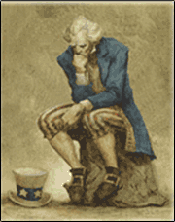Return of the swastika (2)
[Second of a three part series; part one can be found here.]
The transfer of Hitler's loyalty from the House of Habsburg to the House of Hohenzollern became concrete in August of 1914, when Hitler left the Empire to join the German army. But his experiences in the War, while they fastened him ever further upon Germany, ended his adherence to the German Kaiser. From then on, he would break completely with the past, evoking only such elements of it as he could use in his climb to power.
Once arrived at the Chancellery, Hitler faced an awful lot of opposition to either defeat or co—opt: the two major Churches, the nobility, the army, the Socialists, the Communists, rival corporatists, and so on. After Hindenburg's death in 1934, he and his party rapidly pursued a policy of Gleichsaltung ——— 'Coordination.' What this meant was that all of the various interests in the State must be made either to fit into the NSDAP's program, or else eliminated. In piecemeal fashion, this was achieved.
As for Christianity it was the Protestants, due to their lack of organization, who were a bit easier to tackle ——— the more so since, prior to 1918, the Protestant Landeskirchen had functioned more or less as departments of the State, with each Evangelical territorial King, Grand Duke, or Prince functioning as Summus Episcopus ——— 'Highest Bishop,' of his own Church (the Catholic Kings of Saxony and Bavaria were of course left out of this arrangement; the imminent ascension of a Catholic to the throne of W




